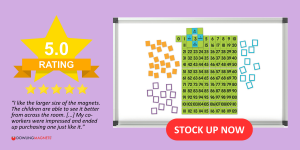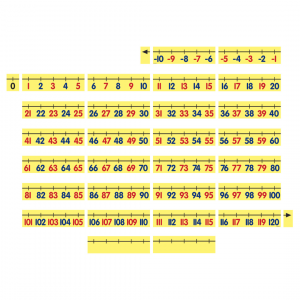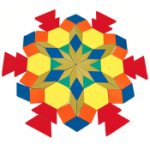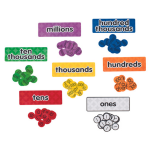Family Math Night Favorites for Math Education Month
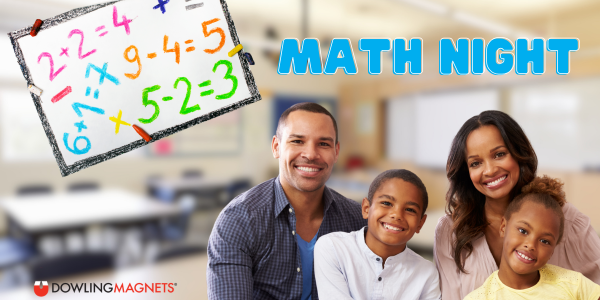
Math Night is a great opportunity to get your students – and their parents – excited about math! To help you create a Math Night your students will never forget, and in honor of Math Education Month, we’re sharing four of our favorite activities sure to help your students shine, including:
1. Exploring the Number Chart
Place our oversized Magnetic Demonstration 0–120 Chart on your whiteboard, along with the included highlighting frames, cover-up squares, and T-shaped more than/less than piece. Encourage students to visit your whiteboard and show off their counting, patterning, addition, and subtraction skills using the chart.
- Grades K–2 students can show their parents how to count by 1s, 2s, 5s, and 10s; use the T-piece to demonstrate concepts like 1 more, 1 less, 5 more, and 5 less; and how to identify the mystery number covered by the cover-up square.
- Grades 3–5 students can demonstrate skip counting by 3s, 4s, and 6s; identify patterns including even and odd, multiples of 10, etc; use the T-piece to demonstrate mental math strategies for adding and subtracting 10s; and more.
2. Number Line Race
Draw an oversized number line on your whiteboard (or give yourself a break and use our quick and easy Magnetic Demonstration Number Line, -10 to 120). Line up several students in front of the board and identify a parent “referee” to call out numbers, number order, and other number challenges. Students or student-parent teams take turns racing to the board to identify the number.
- Grades K–2 students can race to find specific numbers or the number before or after a specific number in a more limited section (i.e., 0–20 for younger kids) of a number line. You can also use masking tape to create a hopscotch pattern on the floor (with taped numbers inside the squares) and have kids identify each number they hop on the way to the board.
- Grades 3–8 students can race to solve equations called out by your referee, for example “35+8”, on the -10 to 120 number line. Referees can also call out a fraction or decimal to find, or even negative numbers.
Seated at their desks, students can use individual Double-Sided Magnetic Dry-Erase Boards and Foam Fun Magnet Pattern Blocks to create patterns. They can demonstrate so many concepts, including geometry, symmetry, and spatial reasoning concepts, to their parents.
- Grades K–3 students can complete verbal or written shape challenges, such as “make a house using 3 triangles and 1 square” or work with their parents to replicate a design from an example card. Parents can also use a dry-erase marker to draw a line on the board and challenge their children to build a symmetrical pattern on both sides of the line.
- Grades 4–8 students can complete larger, more complex shape challenges, such as “make a hexagon using only triangles.” Older students can measure and identify the angles in different shapes they create. Ask students to describe and create tessellations for their parents.
Bonus Activity (all ages):
Describe a mystery shape using verbal clues and challenge students to build it.
4. Place Value War
Using our Magnetic Place Value Disks & Headings and individual Magnetic Dry-Erase Boards, students can demonstrate their understanding of place value concepts to their parents.
- Grades K–5 students can complete written number challenges, like “make the number 357,” by placing disks in the appropriate columns of their Magnetic Place Value Disks & Headings set. In this example, they would place three magnetic disks in the hundreds column, five disks in the tens column, and seven disks in the ones column. Parents and students can each create a number on their boards, then compare to see which number is greater. Parents can also give students a series of continuing clues, such as “I am greater than 100 but less than 200,” until their student finds the correct “mystery number.”
- Grades 4–8 students can use their Magnetic Place Value Disks & Headings to build larger numbers, up to the millions. Parents can also call out a number and challenge their children to build it on the board using the smallest number of disks possible or call out a number and challenge students to round it to the nearest hundred or thousand.
Think of a secret number. (Shh, don’t tell anyone!)
Next, encourage students to ask yes/no questions to try to figure out the number. They can use their disks to track the answers and identify that mystery number.
Now that parents know what you’re working on in class, continue the fun – and practice – AT HOME!
- Grades K–3 students can take home a printed 0–120 chart and work with their families to find and mark number patterns using colored pencils: color skip-counting patterns (2s in blue, 5s in red, 10s in green), circle even numbers, X out numbers ending in 7, and outline number families by column. Layering patterns builds number sense and creates a visual work of mathematical art that they can display at home.
- Grades 3–6 students can do a “Number Line Riddle Challenge.” Send home a blank number line and a few fill-in-the-blank riddles like: “I’m thinking of a number that’s 10 more than 42 and 5 less than 60. What is it?” or “Find a number that is halfway between 36 and 44.” Students solve the riddles and mark their answers on the number line, then write one of their own riddles for a family member to solve!
With the right activities in place, you can count on your Math Night being a booming success! You can find the convenient, reusable, magnetic math products mentioned above – and more! – on our Amazon storefront or find a dealer near you.
Tags: classroom magnet products , classroom magnets , demonstration math magnets , Dowling Magnets , magnetic math products , magnets for learning , math learning magnets , math magnets , math night
Share This:

